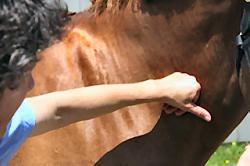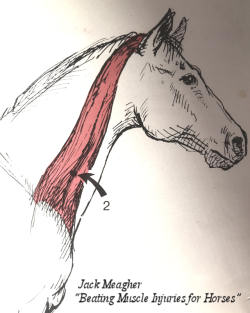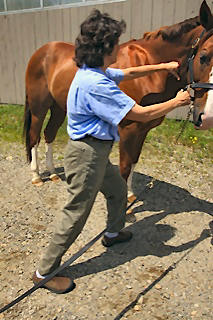|
CASE STUDY: WINTER 2019DIFFICULTY BENDING HEAD
AND NECK
|
|
Is your horse resistant to bending his head and neck to the opposite side in such movements as: Shoulder In Cantering in One Direction Lateral Movement in One Direction Turning in One Direction Half Pass in One Direction? If so, your horse may be reacting to simple muscle tightness in the long and large muscle in his neck. The name of the muscle is the Brachiocephalicus. I met Karen at her barn and her concern was her horse was resistant to bending his head and neck to the right. He tended to bulge to the left when turning to right. He also was a bit short in a straight line in the left front and on a circle he was even shorter in the left front going to the right.
I immediately palpated the Brachiocephalicus on the left side of the neck and found it to be very tight. The right side was tight, but not as tight as the left side. When a muscle is tight, it does not give when you palpate it. It feels rigid, like a board, with no give to it. A loose muscle gives to your hand and feels soft. Location: The brachiocpehalicus is located on the side of the neck starting from the side of the poll and travels all the way down to the point of the shoulder. It is about 3 ½ inches wide and is located directly over the cervical spine. Action: It’s job when the head and neck are fixed, draws the front limb forward, extending the shoulder joint, thus becoming a prime forward mover of the foreleg. Also, and more importantly in this case, it inclines the head and neck to the same side. For example, the left brachiocephalicus moves the head and neck to the left. Result of Muscle Tightness: All muscles must contract and release. They appear in pairs of opposites. If a muscle is tight, it does not fully release to allow for the opposite motion to occur. For example in this case, the left side of the neck was tight. Therefore, it did not release, or let go fully to allow for the opposite motion to occur, such as bending to the right.
Result: After I worked on the horse particularly on the identified muscle, Karen was able to turn her horse’s neck freely in both directions. Her smile, lit up the barn!!!! 
Please refer to our online training video Vol 1 “Difficulty Bending Neck in One Direction” for a hands-on lesson. |
 |



